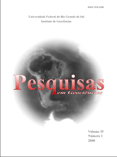Coastline evolution of the Galinhos Spit (NE Brazil) using air photography and landsatTM images
DOI:
https://doi.org/10.22456/1807-9806.20324Keywords:
Remote sensing, coastal evolution, spit.Abstract
Galinhos is one of many spits along the northern coast of Rio Grande do Norte state. Nowadays it has almost 10 km of extension in the E-W direction and medium width of 550 m. Sandy beaches, reefs, estuary, mangroves, lagoon, and dunes are the characteristic geomorphologic features. The modeling of these features is directly correlated with the united performance of waves, coastal current and winds, related with variations of the se level happened in the Quaternary. Aiming to monitoring the evolution of the coastline, it was used aerial photographs from 1954, 1967 and 1988 and satellite images from 1989 and 2000. After georeferred, the images were submitted to several techniques of digital processing, being applied synthesis techniques (dimensionality reduction) and emphasis of the information contained in the same ones, as: RGB colored compositions, index methods (NDWI), analysis for main components (PC’s) and space frequency filtering (directional filters). Each one of the six spectral bands (1-5 and 7) of the Landsat 5-TM and 7-ETM+ were submitted to contrast modifications of the histogram (lineal and no lineal contrast transformations). Among the applied processes, NDWI and the colored composition RGB 432 showed better results to the identification of the interface sea/earth. The application of directional filters allowed to observe submerged features, as sandwaves and photolineaments; the last one also observed in the aerial photographs, with direction NE-SW, which infers the existence of a paleo-channel, cutting the Galinhos spit, suggesting ancient system of island barrier developing for the current spit. The results show a ciclicity of erosional and accretionary processes, as well as the progress of the field of coastal dunes, located in the end East, burying the mangrove vegetation and silting up the tidal channel.



